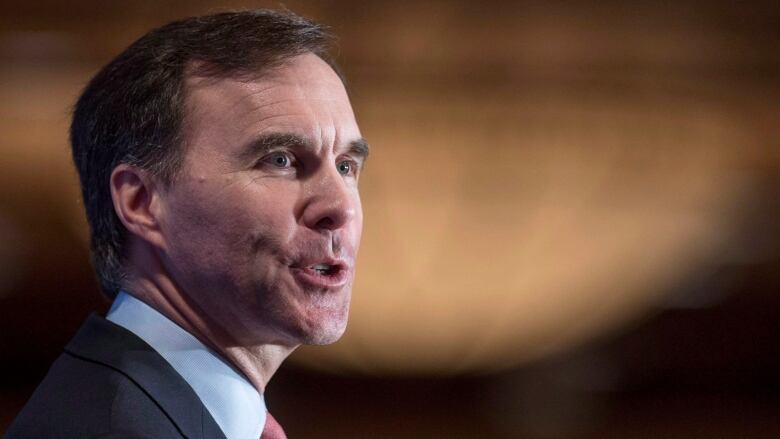Ottawa forecasts $29.4B deficit with lots more red ink to come
But government is taking an intentionally pessimistic view of economic outlook

The Liberal government unveiled its first federal budget on Tuesday, an outline of the new government's spending projections that's awash in big plans and big deficits.
Ottawa plans to spend almost $30 billion more than it takes in this coming fiscal year, a big jump from the $5.6-billion deficit for the current year straddling the previous Tory and current Liberal governments.
- Liberals push deficit to spend big on families, cities
- Liberals keep most of their green election promises in 1st budget
- Highlights of Bill Morneau's first budget
- Federal budget revamps child and family tax benefits
- Deficit vs. debt-to-GDP: Which number should you care about?
The red ink flows from there, to $29 billion the following year, then $22.8 billion and $17.7 billion in 2019-20, the next scheduled federal election year.
All told, it's almost $100 billion in deficit spending, a figure that Finance Minister Bill Morneau said is more than warranted given the current economic climate.
"The government is making the investments needed," he said, "to boost the economy over the long term."
Infrastructure spending
A good chunk of that deficit spending is targeted at infrastructure projects things like highways, bridges and airports that help make it easier for the economy to thrive, and make government tax revenues increase by enough to offset the cost of dipping into the kitty up front.
There's a surge of almost $12 billion in the next five years for so-called "shovel ready" projects such as the Lions Gate Wastewater treatment plant in Vancouver and the Outlet Channels Project that will help flood protection near Lake Manitoba and Lake St. Martin.
There's money to spend on projects like those and countless others, and it breaks down as follows:
- $3.4 billion for public transit.
- $1.4 billion for affordable housing.
- $2.2 billion for water and waste management systems in First Nations communities.
- $400 million for early learning and child care.
- $518 million for climate change mitigation technologies.
- Almost $4 billion in other miscellaneous spending under the grabbag of "infrastructure."
There's even more after that "more than $120 billion in the next decade" according to a government press releasebut the 269-page budget itself was bereft ofdetails onthat spending.
The idea is that projects like bridges and airport improvements pay off for governments down the line by making it easier for companies to grow, which boosts Ottawa's bottom line by increasing the tax base.
And it seems as if that money may have fewer strings attached than usual. Previous governments funded infrastructure projects via a system where municipalities, provinces and cities each covered a third of the costs of any given project.
Tuesday's budget revealed the government is prepared to cover up to half the cost of approved projects. And Ottawa will speed up deployment of about $9 billionthat's left over in a previous infrastructure fund.
But much of that spending may come later. For now, Ottawa's betting on its own future by spending money it doesn't have todayand making some pretty bleak assumptions about the economy in the process.
Lowered expectations
For planning purposes, Ottawa consults with a collective of more than a dozen private sector economists to see how they expect the economy will perform. Those economists expect Canada's GDP to grow by a relatively solid 2.4 per cent in nominal terms this year.
But the government's own assumptions are far less rosy. Ottawa is projecting the economy will grow by $40 billion a year less than its own advisers are saying in each of the next five years.
That level of economic growth would mean about $6 billion less revenue every year for Ottawa, a major factor in the deficit.
But that's not the only management of expectations going on. In its deficit projections, the government is front-loading the spending costs, but not factoring in any of the benefits of the rising economic tide that might ensue.
As Morneau himself said, "for every dollar a government spends on infrastructure, substantially more than $1 of economic activity is generated." Yet the government's own deficit projections seem to assume all that spending won't have enough effectto bring down the deficit over time.
That leaves a lot of wiggle room for the numbers to look a lot better than what we'renow being led to expect .
As Sahir Khan, a senior visiting fellow at the University of Ottawa and formerly of the Parliamentary Budget Office, said: "If the economy does a little better, we're going to pull out."
The government's projections for the price of oil and the value of the dollarpegthem at $40 US and 72 cents USrespectivelyfor the rest of the year on average. Both figures are below their current values.
Bank of Montreal economist Doug Porter agrees with the assessment that thegovernment has intentionally "set the bar low."
"It leaves them room to spend more if need be," he said, "and they can still boast that they beat their targets."
Other changes
Other items that had been rumoured including changes to the way stock options are treated for tax purposes, and an overhaul of capital gains rules aren't mentioned anywhere in the document.
But as Ian Sherman of accounting firm Ernst & Young LLP said, "I would assume those are coming later."
There was also a major change to child-care costs, with the creation of the Canada child care benefit. It replaces a network of previous programs with one centralized one, which the government says will put more money into the pockets of 90 per cent of families with children, and will be tax free.
And there was a tiny amount $500,000 earmarked for Statistics Canada, to give the data agency more tools to be able to track the amount of foreign buying happening in Canada's housing market.
With files from The Canadian Press












_(720p).jpg)


 OFFICIAL HD MUSIC VIDEO.jpg)
.jpg)



























































































